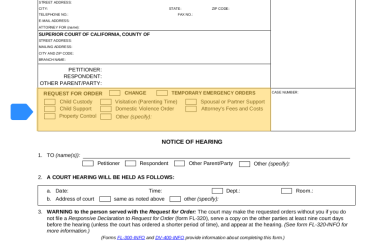Respond to a request to change or end a domestic violence restraining order
To respond to a request to change or end a domestic violence order, you need to:
- Fill out and file a response form
- Have a copy of your response sent to the other side (called serving court papers)
- Prepare for and go your court date
If you're the restrained person and there's a criminal investigation or case related to what happened, you should talk to your criminal lawyer before you put anything in writing. If you don't have a lawyer, you can go to a Self-Help Center to learn more about your options.

What orders they've asked to change
The other side in your case is asking the judge to change the items checked on Page 1 of form FL-300. If the domestic violence orders box is checked, it means that they want to:
- Change the restraining order or
- End the restraining order.
You can find out what about the restraining order they want to change and why in item 7 on Page 4.
How to respond
-
Fill out your response
Use the Responsive Declaration to Request for Order (form FL-320).
This form lets you tell the judge and other side if you agree or disagree with the request and why.
-
Fill out forms for specific situations
Depending on the requests made in the Request for Order (FL-300), you may need other forms.
To respond to requests to change child custody or visitation (parenting time) orders, fill out the forms needed to reply:
- Declaration Under Uniform Child Custody Jurisdiction and Enforcement Act (form FL-105)
- Child Custody and Visitation (Parenting Time) Application and Attachment (form FL-311)
- Request for Child Abduction Prevention Orders (form FL-312)
- Children’s Holiday Schedule Attachment (form FL-341(C))
- Additional Provisions—Physical Custody Attachment (form FL-341(D))
- Joint Legal Custody Attachment (form FL-341(E))
To respond to requests to change child support orders, fill out:
- A current Income and Expense Declaration (form FL-150). You can fill out a Financial Statement (Simplified) (form FL-155) instead if you meet the requirements on page 2 of form FL-155.
To respond to requests to change spousal or partner support orders (or orders about your finances), fill out:
- Current Income and Expense Declaration (form FL-150)
- Spousal or Partner Support Declaration Attachment (form FL-157) (if the request is to change a support judgment)
For attorney’s fees and costs, you need these forms:- Current Income and Expense Declaration (form FL-150)
- Request for Attorney’s Fees and Costs Attachment (form FL-319)
- Supporting Declaration for Attorney’s Fees and Costs (form FL-158)
You can ask your court's Self-Help Center to review your paperwork. They can make sure you filled it out properly before you move ahead with your case.
-
Make copies
After you've filled out and signed your forms, make 2 copies.
-
Take your forms to the court clerk
To file your forms with the court, give the original and the 2 copies to the court clerk. The clerk will keep the original and will stamp the copies and return them to you.
Yes, you can file by mail. Mail your original and 2 copies to the clerk. Include a self-addressed stamped envelope so the clerk can mail your copies back to you. If you do not include a self-addressed stamped envelope you will have to go to the courthouse to pick up your copies.
Some courts allow online filing. You can find out if your court has online filing by visiting your court’s website.
Generally, you do not have to pay a fee to file form FL-320 in a restraining order case. There may be some situations where you have to pay a filing fee. If you are asked to pay a fee and you cannot afford to pay the fee, ask for a fee waiver.

